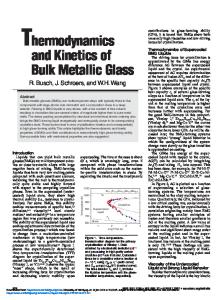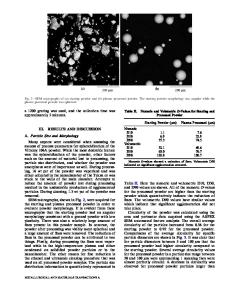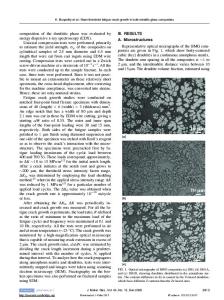Thermoplastic Wire Drawing from Bulk Metallic Glass
- PDF / 480,805 Bytes
- 6 Pages / 612 x 792 pts (letter) Page_size
- 86 Downloads / 425 Views
Thermoplastic Wire Drawing from Bulk Metallic Glass Sven Bossuyt1, Erno Soinila1, Henri Penttinen2, Ville Pulkki2 and Hannu Hänninen1 1
Dept. Engineering Design and Production, Aalto University School of Science and Technology, FI-02015 Espoo, Finland. 2 Dept. Signal Processing and Acoustics, Aalto University School of Science and Technology, FI-02015 Espoo, Finland.
ABSTRACT The low loss coefficient and high elastic energy storage of amorphous metals may provide novel opportunities in the design of stringed musical instruments. To produce prototypes for metallic glass music wire, bulk metallic glass pre-forms were reheated into the supercooled liquid region and stretched into wires. Investigations of these wires’ geometrical, mechanical, and physical properties are reported. The process is relatively simple and could be practical for producing continuous wire. A theoretical analysis shows the importance of the interaction between heating power input, radiative and convective cooling, and area reduction in determining the wire’s final properties.
INTRODUCTION Bulk metallic glasses are here defined as amorphous metals which exhibited a glass transition upon cooling from the molten alloy, without detectable crystallization, in a shape with minimum dimension greater than 1 mm. By Fourier’s law of heat flow, the maximum cooling rate that can be achieved in a bulk object is inversely related to the square of its minimum dimension, so this definition implies that the crystallization kinetics in bulk metallic glassforming alloys are unusually sluggish. As a result, these materials exhibit a practically useful window of time and temperature in the supercooled liquid state above the glass transition temperature, where the shape obtained when the glass was made in the first cooling is only the starting point for easy deformation processes leading to much more complicated shapes. If flow of the material is unconstrained at the surface, particularly in uniaxial tensile testing, strains much larger than unity can be achieved [1,2]. In confined flow, much larger strain rate gradients are needed for large deformations, so the achievable strain is limited by a material formability parameter that takes into account the temperature dependence of viscosity and of crystallization kinetics [3,4]. Thermoplastic forming processes [5] that have been successfully carried out with bulk metallic glasses include imprinting [6-9], extrusion [10], injection molding [11], friction welding [2], manipulation with forceps [7], and blow molding [5]. Inspired by the similarities and differences between blow molding of bulk metallic glasses and the ancient art of glass blowing with silicate glasses, the possibility of fiber drawing by thermoplastic processing of bulk metallic glass was examined. The aim of the process is to reduce the diameter and increase the length of a cylindrical section of a bulk metallic glass
casting, as a precursor to developing capabilities for more complex thermoplastic forming operations. Conventionally, the fiber drawi
Data Loading...











